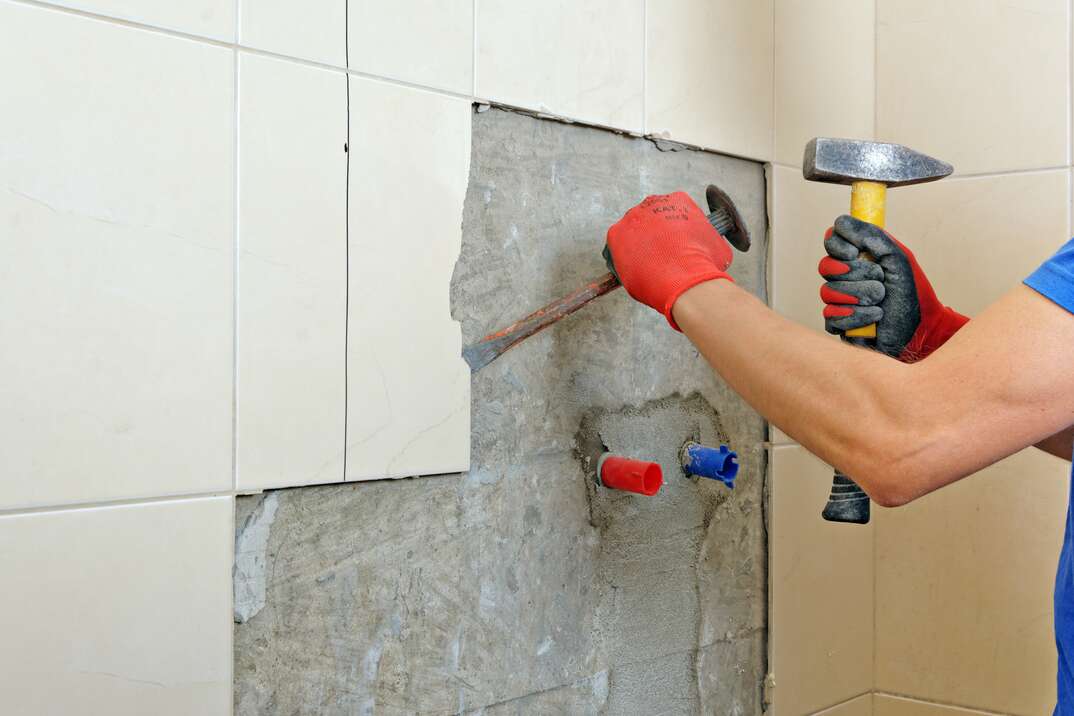Here's How to Remove a Tile Backsplash in 7 Steps

A tile backsplash can be an attractive and functional addition to any kitchen or bathroom. Not only does it keep grease, soap and other substances from getting on your painted walls, but it also offers a spot to add a bit of design flash to the room.
This May Also Interest You: How to Clean a Kitchen Backsplash
That said, you might be ready to update its look, or it may become damaged or too dirty to get cleaned to your satisfaction. If so, you'll need to remove it before putting in a new backsplash.
While removing a tile backsplash can be a challenging and time-consuming task, it’s not impossible. With the right tools and a bit of patience, you can remove your tile backsplash without causing any damage to the wall or countertop.
Removing a Tile Backsplash: Step-by-Step
Things You’ll Need
- Safety glasses
- Heavy-duty work gloves
- Dust mask
- Grout saw or rotary tool with a grout removal attachment
- Putty knife or scraper
- Pry bar
- Hammer
- Rags
- Cardboard or drop cloth
- Joint compound
- Sandpaper
Step 1: Clear the Area
Start by removing any items, such as electrical covers, cabinets or appliances, near the backsplash to avoid damage. Place sheets of cardboard or drop cloths on the countertop to protect it from debris. You can secure these using painter’s tape to keep them in place as you work.
Step 2: Prepare Yourself
Wear safety glasses, heavy-duty work gloves and a dust mask to protect yourself from any tile debris that may fly off during the removal process.
Step 3: Remove Grout
Use a grout saw or rotary tool with a grout removal attachment to remove the grout between the tiles. Be careful not to damage the tiles or the wall behind them, as doing so could make tile removal a little trickier. If possible, select an area of the grout to start with where it may already be loose, and use the grout saw or rotary tool to begin removing it. Cut along the grout lines with the saw or rotary tool. Be careful not to cut into the tiles themselves, or you could damage them. As you work, use a vacuum or a soft-bristled brush to clean up the dust and debris. Repeat the process, cutting away the old grout until it is all removed. Use a vacuum or a soft-bristled brush to clean up any debris that falls onto the countertop.
Step 4: Loosen the Tiles
Insert a putty knife or scraper behind one of the tiles and gently pry it away from the wall. Work your way around the tile, inserting the putty knife or scraper behind each one until they are all loose. If the tiles are difficult to remove, use a pry bar and a hammer to gently tap them away from the wall. Again, do your best here not to crack the tiles or ding the wall, as it will make the job more difficult.
More Related Articles:
- How Much Does It Cost to Install a Backsplash?
- How to Install Kitchen Backsplash in 7 Simple Steps
- Get the Grout Out: How to Remove Grout From Tile
- How Much Does It Cost to Install or Replace Tile?
- Everything You Need to Know About Terrazzo
Step 5: Remove the Tiles
Once the tiles are loose, use your hands to pull them off the wall. If the tiles are stuck, use a pry bar and gently tap it with a hammer to loosen them. Work carefully to avoid damaging the drywall behind the tiles.
Step 6: Clean the Surface
After removing the tiles, use a putty knife or scraper to remove any remaining adhesive or mortar from the wall. Be careful not to scratch the wall or countertop. If there is any adhesive left on the walls, pouring some very hot water on it should loosen it up and help you remove it. If that doesn't work, you can use a solvent-based adhesive remover to soften the adhesive and make it easier to remove. Use your rags to wipe off all the adhesive and a vacuum or soft-bristled brush to clean up any debris that falls onto the countertop.
Step 7: Repair the Wall
If there is any damage to the drywall, repair it with joint compound. Apply a thin layer of joint compound over the damaged area and smooth it out with a putty knife or scraper. Allow the joint compound to dry completely according to the manufacturer's instructions. Once it is dry, sand it smooth with sandpaper.
Make a Splash
Once your old backsplash is removed, you can move on to the fun of choosing a new one!
Removing a tile backsplash can be a challenging and time-consuming task, but with the right tools and a bit of patience, you can do it yourself without causing any damage to the wall or countertop. Remember to wear safety glasses, heavy-duty work gloves and a dust mask to protect yourself from any sharp tile shards or grout dust.


